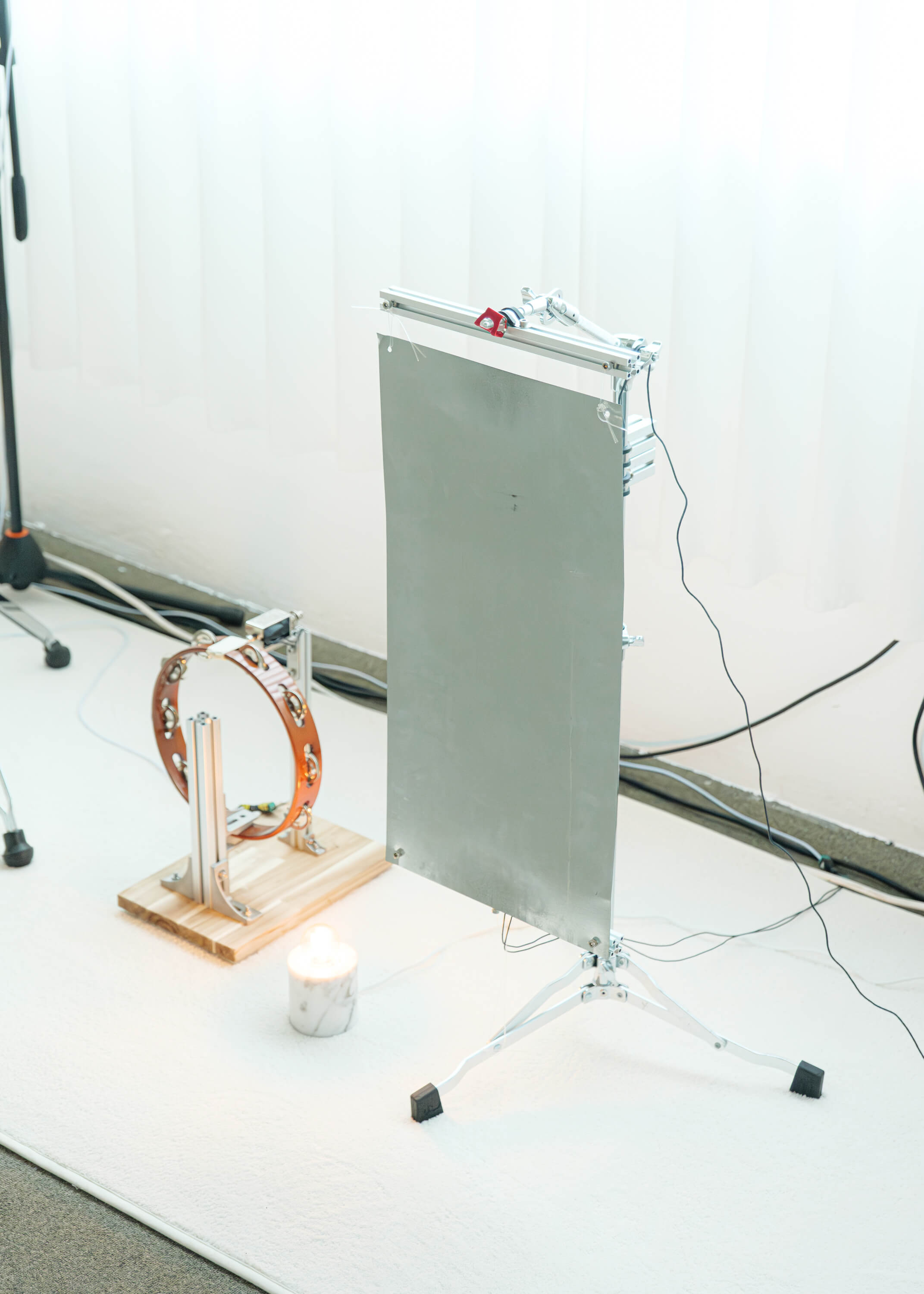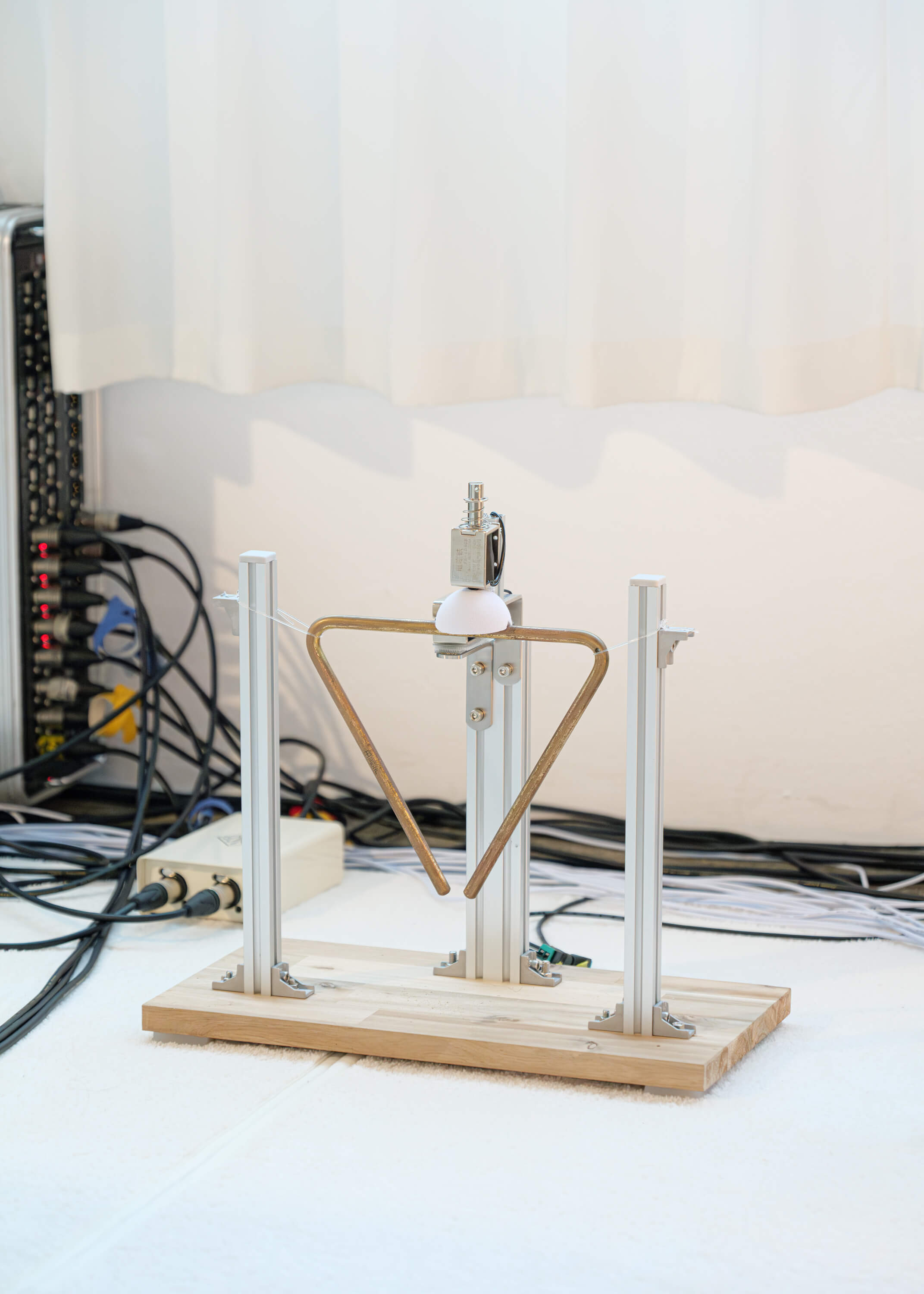Left Behind



















음악가는 무엇을 욕망하는가 (안상욱)
나의 작업실에는 20대 초반부터 모아온 많은 악기들이 있다. 대부분 두드려서 소리를 내는 타악기들인데 세계 각지에서발품을 팔아 모은 소중한 소리의 재료들이다. 오랜 시간 타악기들이 내는 원초적인 소리에 매료되었고 그것을 연주하는기술을 연마했다. 한때 그 악기들의 장인이 되고 싶었던 마음이 있었지만 현재는 그런 마음이 분수에 맞지 않는다는 것을안다. 하나의 악기를 평생을 연마해도 모자랄 텐데 내가 건드려본 악기는 너무 종류가 많았다. 좋은 울림을 가진 악기들에 먼지가 쌓여가고 음악을 연주하는 도구가 아닌 수납장의 컬렉션이 되어가는 시기가 찾아왔다. 최근 몇년간 음악적 관심사가 타악기에서 전자음악으로 옮겨가면서 악기 위의 먼지는 한층 두터워 졌다. <Left Behind>는 작업실에 남겨진 악기들을 바라보던 음악가의 애잔한 시선에서 출발한다.
전자음악에 관심을 가지던 중 전기 신호로 작동하는 동력장치인 솔레노이드를 발견한 것은 밀린 숙제처럼 남겨진 악기들에 대한 부채감을 해소할 단초를 만들어 주었다. 방치되던 악기들에 기계장치를 부착하여 내가 직접 연주하지 않아도연주와 합주가 가능했다. 다른 이들에게 세션 연주를 부탁할 필요도 없고 나는 오직 현재의 관심사에 집중할 수 있다. 망설일 이유 없이 나는 나의 악기들과 함께 음악을 만들었다. 내 악기들이 오직 나의 의도대로 움직이며 합주를 할 수 있다면 어쩌면 이것은 음악가가 오랫동안 바랐던 꿈은 아닐까?
신이 나서 음악을 만들던 음악가는 잠시 망설인다. 이렇게 만들어진 음악을 과연 좋은 작품이라고 주장할 수 있을까? 자동연주장치들의 기원은 1800년대 후반 엔터테인먼트를 위한 목적으로 고안된 <오케스트리온>과 1900년대 초 레코드판이 보급되기 이전까지 활발하게 개발되었던 자동 연주 피아노 <피아놀라>에 있다. 현대의 엔터테인먼트는 그보다훨씬 더 세련되고 간편한 기술들이 많기에 오케스트리온은 오늘날 테마파크에서나 발견되는 구식 장치가 되었다. 본 작품에서 사용된 솔레노이드를 통한 자동 연주장치 역시 최근의 테크놀로지 발전에 비하면 퍽 낡은 기술이다. 만들어진음악 또한 새로움과는 거리가 멀다. 기초적 화성이론에 기대고 있는 조성음악이며 초절정의 기예를 선보이는 것도 아니다. 엄밀히 말해 본 작업에는 새로운 기술도, 새로운 음악사적 지평도 존재하지 않는다. 그렇다면 본 작업은 무엇을 위한예술일까?
질문은 다시 음악가의 욕망으로 돌아온다. 무대 위에서 퍼포먼스를 하는 동안 나는 음악가로서 내가 배우고 연습했던 것들은 최대한 멋지게 해내려고 노력한다. 새로운 미학적 성취가 불확실할지라도 음악가는 굳이 그걸 하고 싶고 잘하고 싶은 욕망을 포기 하지 않는다. 이 욕망은 필연적인 실패를 내포한다. 혼자서 기계회로를 고안하고 수많은 악기들은 컨트롤하는 과정은 매끈한 마스터피스의 구현보다 위태로운 집착에 가깝다. 누군가는 '그냥 사람이랑 합주를 하지 왜 저런 수고를 하는지' 처연한 의구심이 들지도 모른다. 결국 <Left Behind>에서 최종적으로 무대 위에 남겨지는 것은 소리 이전에 불가능한 목표를 위해 노력하는 예술가의 욕망이자 안타까운 실패이다. 그 성실한 수행을 관찰하며 누군가 아름다움을 발견했다면 음악가에게 큰 위안이 될 것이다. 그 곳에 나와 우리가 삶과 음악을 지속하는 단서가 있다고 믿는다.

Credit
작곡,악기제작,연주_ 안상욱
조명감독_이유진
음향감독_ 류호건
무대설치_ 서성협
협력음악프로듀서_ 정중엽
홍보물,홍보영상 디자인_ 보이드 스튜디오
촬영_정근호
기술자문_ 임용주, 서성협
프로듀서_ 이주연
주최/주관: 안상욱
협력: 플랑크톤뮤직
후원: 한국문화예술위원회
* 2023년도 한국예술창작아카데미
What does a musician desire
(An Sangwook)
In my studio, there are many musical instruments that I have been collecting since my early 20s. Most of them are percussion instruments that make a sound by beating. They are precious sound materials collected from all over the world. For a long time, I was fascinated by the raw sound of percussion instruments and honed my skills to play them. I once had a desire to be a master of those instruments, but now I know that I don't fit into my means. It wouldn't be enough to polish one instrument for the whole life, but there were too many kinds of instruments I've interested. There comes a time when dust accumulate on the instruments and becomes a collection of cabinets, not a tool for playing music. In recent years, as musical interests have shifted from percussion to electronic music, the dust on the instrument has become thicker. <Left Behind> starts from the mournful gaze of the musician looking at the instruments left in the studio.
Finding solenoids, which are powered by electrical signals, gave me a chance to relieve the debt of instruments left behind. By attaching mechanical devices to the instruments, it was possible to play and ensemble without having to play them myself. No need to ask othermusicians to play and I can only focus on my current works. No reason to hesitate, I made music with my self-playing instruments. if my instruments can only move and ensemble according to my intentions, maybe this is a long-cherished dream for a musician?
I was so excited but soon hesitated. Can I really claim that the music made in this way is a good? The origins of automatic playing devices lie in the <orchestrion>, which was designed for entertainment purposes in the late 1800s, and the self-playing piano <pianola>, which was actively developed before the spread of vinyl records in the early 1900s. Modern entertainment is much more sophisticated and convenient, and the orchestration has become an old-fashioned device found only in today's theme parks. The Self-playing device using solenoids used in my work is also a very old technology compared to recent technological developments. The music I made is also far from new. It is tonal music that relies on basic harmonic theory and does not show off transcendent techniques. To be honest, there is no new technology or new musical historical horizon in this work. So what is this work of art for?
The question comes back to the musician's desire. While performing on stage, I will try to do as well as possible what I have learned and practiced as a musician. Even if new aesthetic achievements are uncertain, musicians do not give up their desire to do it and to do it well. This desire implies inevitable failure. Someone may have a serious doubt, "Why are you doing such a hard work. Just do an ensemble with a human?" In the end, what is finally left on the stage is the artist's desire and unfortunate failure to strive for an impossible goal before the music. It would be a great comfort to the musician if someone discovered beauty while observing his sincere performance. I believe that there is a clue to me and us continuing our life and music.